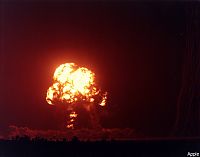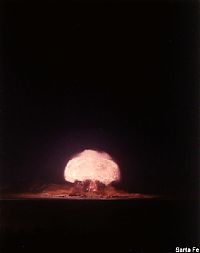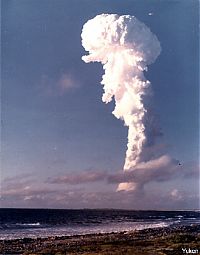|
|
|
|
|
|
|
|
|
|
|
Teapot - Nevada Test Site
|

|


|

|
Operation Teapot
1955 - Nevada Test Site
This series of fourteen shots proof tested a broad variety of fission devices with low to moderate yields. As a group these devices combined several innovations - some previously tested, some introduced during this test series - to create a new pattern of fission device that would dominate the design of all later weapons. These devices used new compact, efficient, light weight spherical implosion systems; beryllium tampers; hollow cores; deuterium-tritium boosting; and the use of neutron pulse tubes as initiators to create light, compact, efficient, and reliable fission explosive systems.
These devices were tested for a broad variety of tactical weapon applications, including air defense (AD) and anti-submarine warfare (ASW). Several new primaries were tested for a new generation of lighter and more compact (Class "D") thermonuclear weapons to be fired in 1956 during Operation Redwing.
UCRL (University of California Radiation Laboratory, now the Lawrence Livermore National Laboratory - LLNL) had its first successful test shots after two and a half years of trying. UCRL demonstrated linear implosion - a non-lensed implosion approach used in artillery shells and other applications where very small diameter systems are required.
Approximately 8,000 DOD personnel participated in the Desert Rock VI exercise which was intended to familiarize troops with the capabilities of nuclear weapons, and the conditions of atomic combat.
LANL test shots were named after flying insects, fruits, and vegetables. UCRL test shots were named after inventors and San Francisco streets. DOD shot names were abbreviations or abbreviation mnemonics.
9 files, last one added on Feb 07, 2005
Album viewed 345 times
|
|
|
|
|
|
Hardtack II - Nevada Test Site
|

|


|

|
Operation Hardtack II
1958 - Nevada Test Site
Hardtack II included 37 tests, the largest test series so far, exceeding the 35 tests of the just completed Hardtack I. Hardtack I had focused primarily on high yield proof or developemental tests of complete thermonuclear weapons, which necessitated it be conducted in the distant Pacific (a total of 35.6 Mt being fired). In contrast, Hardtack II consisted exclusively of low yield tests, many of them attempted zero-yield one-point safety tests, which could be conducted in relative safety in Nevada (some were underground). Only 45.8 kt total was fired in Hardtack II, and of this only 18.5 kt was fired above ground.
The Los Alamos (LASL) shots had names taken from New Mexico counties. The Livermore (UCRL) shots had names of North American mountains, Roman gods and goddesses, and the fairies of A Mid-Summer Night's Dream.
3 files, last one added on Feb 07, 2005
Album viewed 287 times
|
|
|
Dominic - Christmas Island, Johnston Island, Central Pacific
|

|


|

|
Operation Dominic
1962 - Christmas Island, Johnston Island, Central Pacific
Dominic included 36 tests. The majority of the tests (29 airdrops) were weapons development tests, intended to evaluate advanced designs that the labs had been cooking up during the years of the moratorium and before. Five rocket-launched tests were conducted to gather further weapons effects data on high-altitude phenomena. Two tests of operational weapon systems were conducted - the Polaris submarine launched ballistic missile and the ASROC anti-submarine rocket.
Conducted as part of Operation Dominic was a series of high altitude tests known as Operation Fishbowl. These tests were Thor missile launched warheads detonated at very high altitudes (30-248 miles) to evaluate the destructive mechanisms and effects of high yield explosions against ballistic missile RVs. Several test failures occurred with missiles being destroyed in flight by range safety officers when electronics failed (Bluegill), when rocket motors malfunctioned (Starfish and Bluegill Prime), or when the missile veered out of control (Bluegill Double Prime). The Bluegill Prime test was particularly disastrous since the missile was blown up while still on the launch pad, requiring complete reconstruction of the demolished and plutonium contaminated Thor launch facility.
16 files, last one added on Feb 07, 2005
Album viewed 418 times
|
|
|
|
|
|
